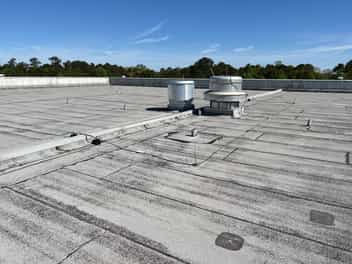- Home »
- Learningcenter »
- Tpo roll modified bitumen
TPO Roll Roofing Versus Modified Bitumen: Pros and Cons
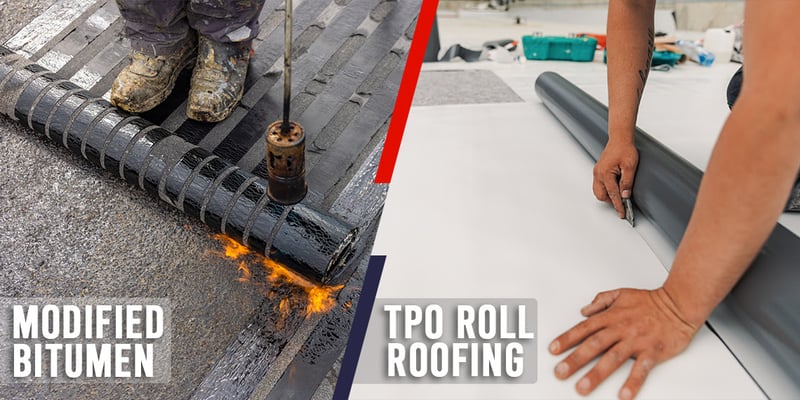
Choosing the right roofing material is a big decision, but it doesn't have to be an overwhelming one.
TPO, otherwise known as Thermoplastic Polyolefin, is like the cool newcomer on the block. It's great at reflecting sunlight, helping to keep your building cooler, and potentially saving you some cash on energy bills. It's a solid pick for buildings with flat or gently sloping roofs that are looking for a modern, energy-efficient option.
Think about modified bitumen as the seasoned veteran; it's like your useful pair of hiking boots - tough and ready for all kinds of weather. Its strength comes from its layered technique, which can handle lots of foot traffic as well as these unpredictable weather changes. If your area swings between hot sun and cold rain, this could be your best bet.
Let's break it down so you can make an informed choice without the stress!
Cost-Effectiveness and Installation of TPO Roofing
Choosing the best covering for flat roofs means you need to think about what the building needs and what the weather is like in your area. Say you're deciding between parts like TPO, which stands for Thermoplastic Polyolefin, or Modified Bitumen. If your building gets a lot of sunshine, TPO is awesome because it can bounce back some of that heat and help keep cooling costs down.
If we're talking about putting it in place, TPO kind of shines here - it's fast to install, so workers can get more done in less time. That's great for your wallet because it means you're paying less for labor. Also, TPO is really light, which makes it easier to move around and can speed up your project.
But wait a minute. I'm talking about how much it costs at the start. You really have to look at how long it's going to last. TPO is getting better, but we're still figuring out if it can go the distance, especially when compared to Modified Bitumen, which is known for being super tough.

TPO has a green side, too. It keeps buildings cooler and helps towns stay a bit cooler as well - it's like wearing a light-colored T-shirt on a hot day. The only thing is, when it's time to get rid of TPO, it's not the best for the environment. On the other hand, you can recycle Modified Bitumen, which is also a big Issue.
TPO's price might be tempting, and it does help with energy bills, but you have to think about the long haul. Questions like, how will this roof handle rain, or just daily things? Put on your thinking cap and think about all this. At the end of the day, remember the roof's cost includes fixing it up over time and possibly having to replace it.
Look at TPO Roofing Durability and Flexibility
Let's talk about a roofing material that's quite popular for big buildings - think shopping centers or offices. It's called TPO roofing, and it's basically a really tough mix that does an awesome job of holding up against sunlight, rips, holes, and even mold. These things stay in great shape for years because the seams - where the material joins together - are melted to create a waterproof seal that's super strong, keeping everything dry inside.
You might have heard some chatter about whether TPO can really take the heat, especially in really hot places. Some people worry that it might not hold up well over time in the intense sun. While it's true that some TPO roofs might show some wear and tear a bit sooner than expected, typically, these roofs are solid for anywhere from 10 to 25 years, and the warranties might even promise more.
One of the best things about TPO roofing is that it's flexible. This means that when the weather throws some extreme temperatures its way, TPO can bend without breaking - literally. This flexibility is also huge for buildings that settle over time because the roof just adjusts without a fuss.
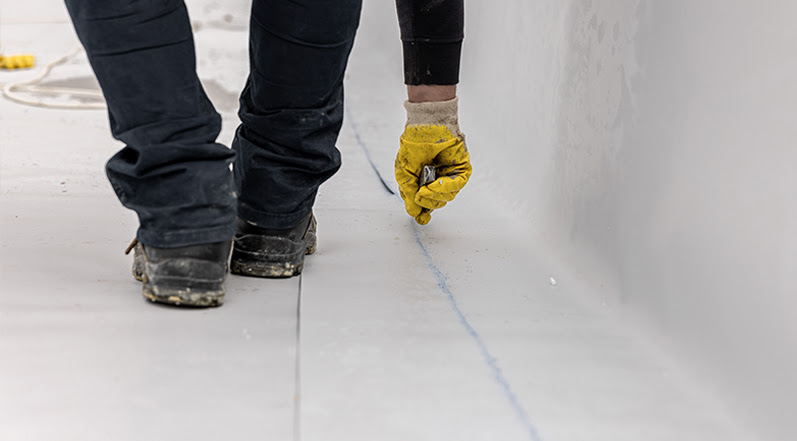
You'll find TPO roofing in various thicknesses and sizes, so it can fit a whole bunch of different design needs. Also, then one way to install it - you can screw it down, glue it, or even weigh it down with rocks.
When picking out a roof, remember you have to think about the weather and environment. TPO roofs are a solid choice that can handle a lot, but only if you pick the right type for your particular situation, especially if your building is going to face some rough weather or chemicals that could shorten the roof's life.
So, there you have it - TPO roofing could be a pretty good option for your building, as long as you bear in mind the kind of challenges your roof will face. Keep in mind that with the right type, your roof will be keeping you covered for years to come.
Confront Cons of TPO Roofing
If you're thinking about TPO roofing because it's easier on the wallet than PVC, it's smart to dig into what it costs. You want to make sure you're making a choice you won't regret later on.
Not all roofers have the special tools you need for TPO fixes, like heat welders. This might make the repair a bit more expensive since these tools aren't just lying around. Also, the people who know how to use them are kind of rare, and their expertise usually comes with a higher price tag.
The thing is, even though TPO roofs are getting more popular, there aren't a lot of pros who really know their things with this newer material. Fewer experts could mean a bigger chance of the roof not being put on right, which can be a sneaky problem that you don't spot until it's too late.
In places where the sun is super strong, and the heat is intense, TPO roofs are in the hot seat. The heat and UV rays from the sun can be tough on the roof, especially at the seams. And let's be honest; if these seams give you trouble early on, it's not exactly a good look for TPO roofs.
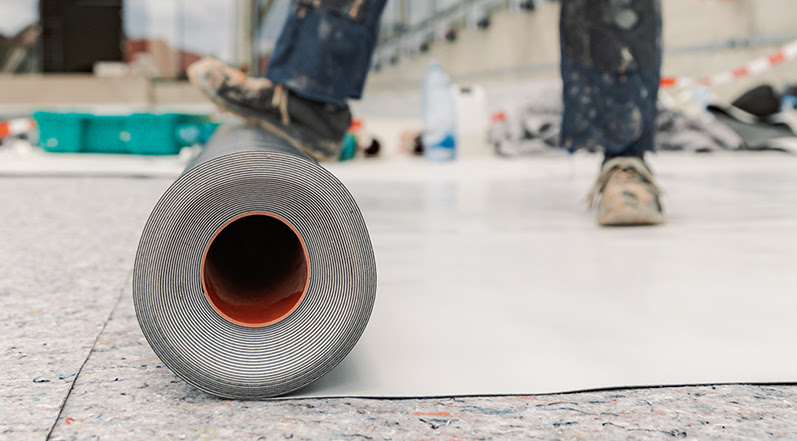
Another point to mull over is that not all TPOs are created equal. Some manufacturers make it better than others, so the brand you pick can really make or break how long and how well your roof holds up.
Also, we've had to talk about how TPO handles really hot or really cold weather. The heat can mess with the seams and flashings, and if it gets cold, the roof surface might even crack. That's why it's so important to choose parts that can take a beating from mother nature.
Lastly, I know what you're thinking, "Is there enough proof that TPO roofs will last?" Honestly, because it's a bit new on the scene, there isn't a ton of long-term data yet. That means you should think about whether you're okay with taking a gamble on something that's still proving itself. Remember, it's in finding a roof that fits your needs and how much risk you're willing to take on.
Durability and Cold Weather Performance of Modified Bitumen
Roofing can be a mind-boggler, but let's talk about it as if I'm sharing a secret with my friend - you'll want in on this. Picture a superhero version of regular tar-like roofing material - that's modified bitumen for you. It's like giving it a super suit made of special things we call polymers, with want-to names like APP and SBS. These polymers are a magic touch, which makes the material tough as nails, so it can take on more damage without getting a scratch.
Think about it like this: you know how some people can stretch like rubber bands? That's what SBS does; it lets the roof move and groove with the weather, so it doesn't crack when it gets cold. And when that rapid sun tries to beat down on your roof, APP comes in like a pair of super sunglasses, which makes sure your roof doesn't sweat a bit.

You're probably wondering, "What if I live where it's pretty much a winter wonderland year-round?" Well, don't worry; there's a specific superhero for that, too - SBS-modified bitumen. It scoffs at the cold, staying crack-free even when the thermometer's dropping fast. Installation is also very easy; no flame torches are needed. It's honestly a stick-and-go thing that makes roofers' lives very easy, especially when their breath is fogging up from the cold.
If you're in the market, check out cool gear like the Elastoflex from Polyglass. It's tailor-made for the cold, so it's like giving your roof a warm hug. Modified bitumen roofs are quite the champs at keeping their cool - or warmth - when temperatures do that crazy dance between freezing and frying.
It flexes, it fights UV rays, keeps your indoors dry, and overall, is a solid choice. How awesome is that? And remember, no matter what the weather does, this roof can dance to any tune - at the end of the day, that's why we love it.
Compatibility and Application Risks of Modified Bitumen
Mod Bit needs to play nice with the parts around it. If it cuddles up too close to oils and greases, say from a kitchen fan nearby, it's not going to last as long as you'd hope. It's a bit like putting on a raincoat only to walk through a storm of cooking oil - it won't end well.
Believe it or not, Mod Bit is quite the social butterfly with asphalt-based things. It's like they were meant to be best friends. This makes fixing up things later down the line a lot smoother. But not all relationships are perfect. You see, Mod Bit and certain other roof parts - EPDM and PVC - don't get along. Put them together, and you might find yourself with a damaged roof instead of protection from the features.
Let's talk safety - installing Mod Bit isn't a DIY project. Pros who know their things, specifically those with CERTA training, are the only ones who should be using the torches needed for this job. It's to make sure no one accidentally starts a barbecue on your rooftop. You have to think about the fumes, too. Nobody wants to breathe in nasty things, so a well-aired space is mega important.
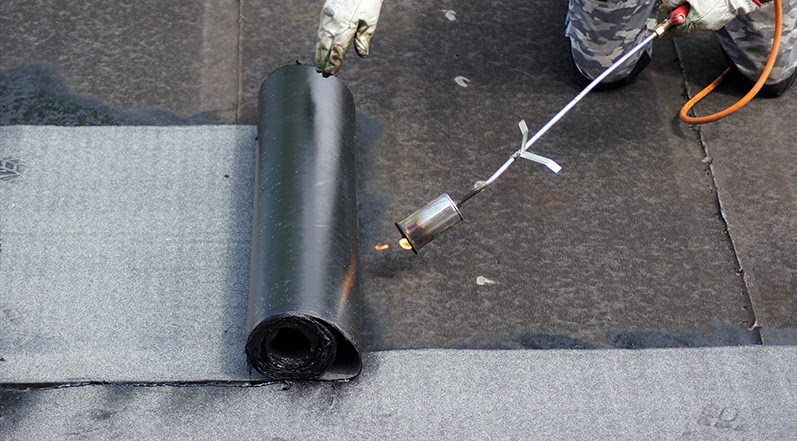
Think about it: when the time comes to lay down Mod Bit, getting the temperature just right is non-negotiable. If it's a bit chilly, you have to warm up that Mod Bit like it's getting ready to run a marathon - roll out those sheets to make them stick.
Since we're on the topic of the planet and keeping healthy, we had to think about these solvent-based gooey adhesives used with the Mod Bit sheets. To cut down worries about breathing in something toxic, proper airflow is your friend. And in cold weather, keep an eye on your asphalt temperature - it's like making sure your coffee is hot enough to give you that morning kick.
Keep in mind that exhaust and such from the roof might want to mess with your Mod Bit. To keep your roof in tip-top shape, think about putting in some buffers, like filters, and stick to a regular check-up to keep things tidy and intact. Do this right. Mod Bit can be a useful umbrella over your building, especially if it's more of a pancake than a mountain, if you catch my drift.
Installation Costs vs Long-Term Savings
When you're picking out a roof, think about it like you're choosing a new car. You wouldn't just look at the price tag; you'd think about the gas mileage and maintenance, too, right? Starting off, single-layer roofs might be lighter on your wallet - they're simpler to lay down and don't need as many parts. But here's the catch: double-layer roofs are usually tougher and last longer, which could mean less money spent on fixing things later on.
To really get your money's worth from a tough roof, it's in keeping it in tip-top shape. Skip out on this, and any cash you saved at the start could slip through your fingers. I know what you're thinking - these sturdy roofs are like wearing a black t-shirt in the summer sun; they get hot! But, believe it or not, there's a clever fix: special shiny coatings bounce back the sunlight, helping you save a bundle on staying cool.

So, when you're looking at that price tag, don't stop there. Think about the dough you'll save on your energy bills, too. With the right care and these useful reflective coatings, the costs over your roof's lifetime can actually be way lower, giving you a sweet spot between being tough and energy-friendly.
At the end of the day, don't just pull the trigger on something because it's cheap upfront. Remember, being legitimate involves thinking ahead about energy savings, which can totally change the game with how much you give for your roof over the years. Stay smart and think about these hidden savings to make sure you're really getting the best bang for your dollar.
Does Modified Bitumen Have a Problem With Water?
Bitumen roofing is really tough and long-lasting, but watch out; it doesn't like pooling water much. This is when water hangs out on your roof too long after it rains because it has nowhere to go. When this happens, it's usually a sign that the water can't drain properly, which isn't good.
Water that stays put for too long can also make UV damage worse. It can weaken the roof's stickiness and heat things up, causing leaks, which can, frankly, be a big headache for the building underneath.
What's the fix? Well, it starts with installing the roof right, which makes sure it tilts enough so water can run off easily. Keep these drains clear and get the roof checked commonly, so you spot trouble before it gets worse. If you see water sticking around, you might need to fix the slope or beef up the insulation to spread out the water.
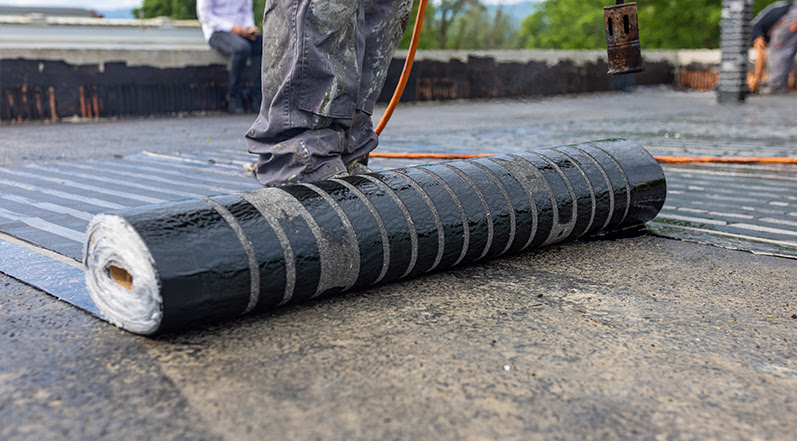
Here's the thing: a dry roof is a happy roof, and that mostly comes down to having an impressive crew put it in. They have to angle it just right and seal it up tight to keep the water out.
If you're in a wet place or your roof is as flat as a pancake, be super careful about water puddles. You have to keep up with roof inspections and maintenance like nobody's business. A little care goes a long way and keeps your building safe and sound.
Make Your Informed Decision
Choosing the right roof is easier than you might think. Just think about what you need. If you're trying to keep your energy bills down, how about a white, shiny TPO roof? It reflects the sun and keeps things cool, and it's light and not hard to put up - pretty practical. Or, if you have a lot of people walking on your roof, tough modified bitumen could be better. It has this gritty layer for extra toughness.
Your choice depends on a few big things: how your building looks, the kind of weather you get, and how much money you want to spend. So, what's more important for you? Battling the features or saving on electricity?

If you're stuck between options, it's smart to ask the pros here at Colony Roofers. We know our things in Georgia, Florida, and Texas and will give you the advice you need. Whether it's your business or your home, we promise great quality and a roof that's going to last.
Don't stress over picking a roof. Get in touch with Colony Roofers - we'll even check out your roof for free. Remember, a roof is just the parts - it's the shield for your place. With Colony Roofers, you're guaranteed great service and safe and solid roofing.
 Call (678) 365-3138
Call (678) 365-3138

